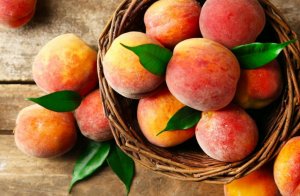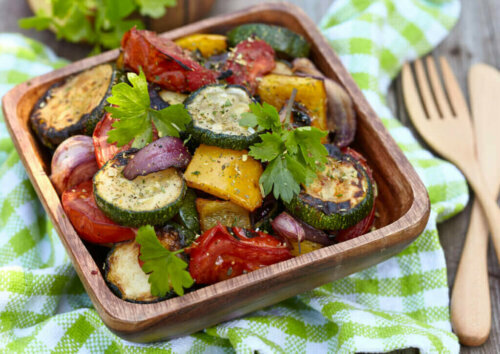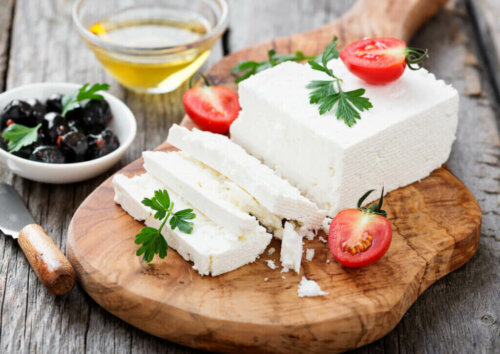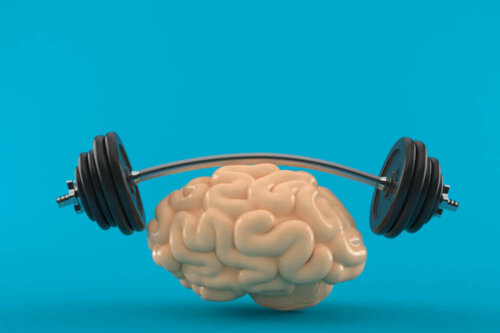Benefits of Peaches

Peaches are a seasonal fruit, popular in spring and summer. They have a “fuzzy” skin, a sweet, juicy interior, and their coloring depends on the variety. Ranging from yellow to orange and even pink, the center contains a large pip or stone.
Benefits of Peaches
Peaches and diabetes
Peaches are low-carbohydrate fruits which means they are ideal for people who suffer from diabetes, as well as anyone following a strict diet. They are also high in fiber which helps the body to process carbohydrates efficiently and avoids blood sugar spikes, otherwise known as glycemia.

Benefits for high blood pressure
Another benefit of the peach is related to hypertension. People who suffer from this problem, or who are at risk of high blood pressure, can still enjoy peaches. This is because they’re high in potassium and low in sodium, which is the leading cause of raised blood pressure.
Peaches and constipation
The high amount of insoluble fiber in peaches is important for maintaining a regular digestive system, and it can prevent or alleviate constipation. The fruit can also help to prevent (to a certain degree) more serious diseases such as colon cancer.
Strengthens your immune system
Peaches contain a component found in carotene, an antioxidant that helps to strengthen and improve our immune system. They also help to fight the damage caused by free radicals and can prevent or delay illness.
Peaches and vision
Carotene, the same antioxidant that we mentioned above, is also an important factor for vision care. Carotene helps to prevent common optical diseases such as cataracts or loss of night vision.
Hair skin and nail health
All of the antioxidants contained in peaches, especially carotene, help to maintain skin, hair and nail health. These antioxidants help to nourish hair, skin, and nails and prevent common conditions or problems in these areas.

Peaches also contain high levels of vitamin C, which aids in the formation of the collagen that keeps skin soft, supple, and wrinkle-free. Perfect for those of us who want to stay looking young!
Peaches for anemia and fatigue
Peaches are a good source of vitamin C which helps the body to absorb iron. Dried peaches retain a high concentration of iron, making them ideal for preventing anemia caused by iron deficiency and fatigue. Including these fruits in your daily diet is highly recommended and you can choose either dried or fresh peaches.
Digestive benefits
Recommended for indigestion because of their ability to regulate the digestive process, peaches help prevent sluggish digestion by helping to digest fatty foods.
Peaches and varicose veins
Peaches also contain high levels of an important element called coumarins that strengthen your capillaries, which can help prevent cardiovascular problems and varicose veins.
In conclusion, the peach is a fruit with a myriad of benefits and should be included in a healthy diet. If you suffer from any of the health problems that we mentioned, start eating more of this superfood.
Peaches are a seasonal fruit, popular in spring and summer. They have a “fuzzy” skin, a sweet, juicy interior, and their coloring depends on the variety. Ranging from yellow to orange and even pink, the center contains a large pip or stone.
Benefits of Peaches
Peaches and diabetes
Peaches are low-carbohydrate fruits which means they are ideal for people who suffer from diabetes, as well as anyone following a strict diet. They are also high in fiber which helps the body to process carbohydrates efficiently and avoids blood sugar spikes, otherwise known as glycemia.

Benefits for high blood pressure
Another benefit of the peach is related to hypertension. People who suffer from this problem, or who are at risk of high blood pressure, can still enjoy peaches. This is because they’re high in potassium and low in sodium, which is the leading cause of raised blood pressure.
Peaches and constipation
The high amount of insoluble fiber in peaches is important for maintaining a regular digestive system, and it can prevent or alleviate constipation. The fruit can also help to prevent (to a certain degree) more serious diseases such as colon cancer.
Strengthens your immune system
Peaches contain a component found in carotene, an antioxidant that helps to strengthen and improve our immune system. They also help to fight the damage caused by free radicals and can prevent or delay illness.
Peaches and vision
Carotene, the same antioxidant that we mentioned above, is also an important factor for vision care. Carotene helps to prevent common optical diseases such as cataracts or loss of night vision.
Hair skin and nail health
All of the antioxidants contained in peaches, especially carotene, help to maintain skin, hair and nail health. These antioxidants help to nourish hair, skin, and nails and prevent common conditions or problems in these areas.

Peaches also contain high levels of vitamin C, which aids in the formation of the collagen that keeps skin soft, supple, and wrinkle-free. Perfect for those of us who want to stay looking young!
Peaches for anemia and fatigue
Peaches are a good source of vitamin C which helps the body to absorb iron. Dried peaches retain a high concentration of iron, making them ideal for preventing anemia caused by iron deficiency and fatigue. Including these fruits in your daily diet is highly recommended and you can choose either dried or fresh peaches.
Digestive benefits
Recommended for indigestion because of their ability to regulate the digestive process, peaches help prevent sluggish digestion by helping to digest fatty foods.
Peaches and varicose veins
Peaches also contain high levels of an important element called coumarins that strengthen your capillaries, which can help prevent cardiovascular problems and varicose veins.
In conclusion, the peach is a fruit with a myriad of benefits and should be included in a healthy diet. If you suffer from any of the health problems that we mentioned, start eating more of this superfood.
All cited sources were thoroughly reviewed by our team to ensure their quality, reliability, currency, and validity. The bibliography of this article was considered reliable and of academic or scientific accuracy.
- Ananieva, L., & Novelli, V. (2018). Aceites esenciales para su salud y belleza: Segunda parte. Tektime.
- Asociación Americana de Diabetes. Principios y recomendaciones de nutrición basados en la evidencia para el tratamiento y la prevención de la diabetes y las complicaciones relacionadas. Diabetes Care 1 de enero de 2003; 26 (suplemento_1): s51–s61. https://doi.org/10.2337/diacare.26.2007.S51
- Carlos Zehnder, B. (2010). Sodio, potasio e hipertensión arterial. Revista médica Clínica Las Condes, 21(4), 508–515. https://doi.org/10.1016/s0716-8640(10)70566-6
- Cassiem, W., de Kock, M. (2019). El efecto antiproliferativo de los extractos de hueso de albaricoque y melocotón en células de cáncer de colon humano in vitro. Complemento BMC Altern Med 19, 32. https://doi.org/10.1186/s12906-019-2437-4
- Corio Andújar, Rosario & Vicente José Orós Espinosa. La diabetes: cómo combinar nutrición y gastronomía. Cursos de Gastronomía y Nutrición. https://cursos.gan-bcn.com/cursosonline/admin/publics/upload/contenido/pdf_14172861340188506.pdf
- E. Nova, A. Montero, S. Gómez y A. Marcos. La estrecha relación entre la nutrición y el sistema inmunitario. Cap.I. Soporte Nutricional en el Paciente Oncológico. Grupo de Inmunonutrición. Dpto. Metabolismo y Nutrición. Instituto del Frío. Consejo Superior de Investigaciones Científicas. Madrid. https://seom.org/seomcms/images/stories/recursos/infopublico/publicaciones/soporteNutricional/pdf/cap_01.pdf
- FEN, & de la Nutrición, F. F. E. (n.d.). Alimentos y Bebidas. FEN. Fundación Española de la Nutrición. Retrieved December 9, 2022, from https://fen.org.es/MercadoAlimentosFEN/pdfs/melocoton.pdf
- Giménez Soro, R., Agreda, L., Ksia, E., Abidi, W., Torrents, J., Moreno Sánchez, M. Á., & Gogorcena Aoiz, Y. (2015). Selección de melocotón de carne dura con alto contenido en azúcares y antioxidantes. Giménez R, Agreda L, Ksia E, Abidi W, Torrents J, Moreno MA, Gogorcena Y. Selección de melocotón de carne dura con alto contenido en azúcares y antioxidantes. Actas de horticultura, 71, 445–448. https://doi.org/10.13039/501100003329
- Meléndez-Martínez, Antonio J., Vicario, Isabel M., & Francisco J., Heredia. (2004). Importancia nutricional de los pigmentos carotenoides. Archivos Latinoamericanos de Nutrición, 54(2), 149-155. Recuperado en 11 de diciembre de 2022, de http://ve.scielo.org/scielo.php?script=sci_arttext&pid=S0004-06222004000200003&lng=es&tlng=es.
- Nutrición, alimentación y actividad física si se tiene diabetes. (2022, December 5). National Institute of Diabetes and Digestive and Kidney Diseases; NIDDK | National Institute of Diabetes and Digestive and Kidney Diseases. https://www.niddk.nih.gov/health-information/informacion-de-la-salud/diabetes/informacion-general/nutricion-alimentacion-actividad-fisica
- Urdampilleta Otegui, Aritz & Martínez Sanz, José Miguel & J, Mielgo & Javier, Yanci. (2012). Iron deficiency anemia in sports and nutritional intervention. Universidad del País Vasco. https://www.researchgate.net/profile/Yanci-Javier/publication/258834183_Iron_deficiency_anemia_in_sports_and_nutritional_intervention/links/00b7d5290fb936dc91000000/Iron-deficiency-anemia-in-sports-and-nutritional-intervention.pdf
This text is provided for informational purposes only and does not replace consultation with a professional. If in doubt, consult your specialist.








